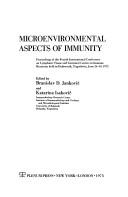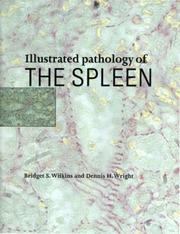| Listing 1 - 10 of 46 | << page >> |
Sort by
|

ISBN: 0306390299 Year: 1973 Publisher: London : Plenum press,
Abstract | Keywords | Export | Availability | Bookmark
 Loading...
Loading...Choose an application
- Reference Manager
- EndNote
- RefWorks (Direct export to RefWorks)
Immunity --- Lymphoid tissue --- Congresses. --- Congresses.
Dissertation
ISBN: 9782875430151 Year: 2012 Publisher: Liège : Presses de la Faculté de Médecine Vétérinaire de l'Université de Liège,
Abstract | Keywords | Export | Availability | Bookmark
 Loading...
Loading...Choose an application
- Reference Manager
- EndNote
- RefWorks (Direct export to RefWorks)
Scrapie --- Sheep --- Antibodies --- Lymphoid tissue --- pathology --- immunology
Book
ISBN: 1789851343 1789851335 Year: 2020 Publisher: [Place of publication not identified] : IntechOpen,
Abstract | Keywords | Export | Availability | Bookmark
 Loading...
Loading...Choose an application
- Reference Manager
- EndNote
- RefWorks (Direct export to RefWorks)
Thymus. --- Thymus gland --- Endocrine glands --- Lymphoid tissue

ISBN: 1107114934 051111687X 0511303254 0511545975 051105050X 1280153261 0511152485 9786610153268 0511019637 9780511019630 9780511050503 9780511116872 9780521622271 0521622271 6610153264 9781107114937 9780511303258 9780511545979 9781280153266 9780511152481 0521622271 Year: 2000 Publisher: Cambridge New York, NY Cambridge University Press
Abstract | Keywords | Export | Availability | Bookmark
 Loading...
Loading...Choose an application
- Reference Manager
- EndNote
- RefWorks (Direct export to RefWorks)
The major aim of this book is to de-mystify splenic pathology for non-specialist consultants and trainees in histopathology. The interpretation of pathological changes in the human spleen provides a significant challenge to the skills of even the most highly trained histopathologists. This comprehensive account of the most important and frequently encountered pathological conditions affecting the spleen is highly illustrated in colour throughout with numerous detailed macroscopic and microscopic specimens. Emphasis is placed upon the importance of adequate clinical information and technical preparation of splenectomy specimens in obtaining the best possible histopathological assessment of the tissue. A systematic, analytical approach to interpretation of pathological changes is used throughout the book. This should enable readers to feel confident in their assessment of significant processes within the spleen. This volume serves as an illustrated atlas, a bench manual, as a text, and as a source of reference, and will be an indispensable guide.
Spleen --- Hematopoietic system --- Lymphoid tissue --- Histopathology.
Book
ISBN: 1799620794 183968559X Year: 2020 Publisher: London : DIGITAL MEDIA LEARNING,
Abstract | Keywords | Export | Availability | Bookmark
 Loading...
Loading...Choose an application
- Reference Manager
- EndNote
- RefWorks (Direct export to RefWorks)
The thymus gland is highly valuable, due to its functions as a part of the neuroendocrine system as well as its actions to provide a primary lymphoid microenvironment that efficiently carries T-cell differentiation and selection. This book begins with an introduction and explanation of the development of the thymus. Subsequent chapters examine a range of conditions - including environmental pollution, congenital anomalies, autoimmune diseases, and malignancies - that threaten the function and development of the thymus. The information presented herein is useful for a wide range of readers across a variety of specialties.
Thymus. --- Thymus gland --- Endocrine glands --- Lymphoid tissue
Dissertation
Abstract | Keywords | Export | Availability | Bookmark
 Loading...
Loading...Choose an application
- Reference Manager
- EndNote
- RefWorks (Direct export to RefWorks)
Lymphoid Tissue --- Lymphoid Tissue --- Endothelium, Vascular --- Lymphocyte Subsets --- Palatine Tonsil --- cytology --- immunology --- cytology --- cytology --- cytology
Book
Publisher: Bruxelles: UCL,
Abstract | Keywords | Export | Availability | Bookmark
 Loading...
Loading...Choose an application
- Reference Manager
- EndNote
- RefWorks (Direct export to RefWorks)
In clinical practice, the ability to identify the presence of an abnormality on a blood smear is an important reliability determinant of a differential counting method. The clinical impact of a wrong differential count can be significant, which necessitates the presence of highly trained personnel for the microscopic review of the blood smears. However, interobserver and intraobserver variations in microscopy lead to difficulties in maintaining consistency in interpretation when rare events occur (generally less or equal to 2 % variation in the differential counts). Previously, studies employing automated image analysis systems dedicated to preclassifying the various types of WBC in peripheral blood smears, were performed in comparison with optical microscopy. In this work, we compare the results of final results obtained after morphological reclassification of cells by an expert technician in morphology using a digitizing microscope, the HemaCAM® system (n= 200 cells evaluated) with those obtained by optical microscopy (n=400 cells counted by two independant technologists) but also with those obtained by flow cytometry (FCM), considered as the reference method (“gold standard”), for blasts and lymphomatous ceils. In our comparison, we focused on 41 patients suffering from haematological neoplasias. We assessed the capability of the HemaCAM®, operating by a technician to classify accurately leukocytes and to detect abnormal circulating ceils (blast ceils, lymphomatous cells, immature myeloid ceils, plasma cells and NRBC). Blast cells and lymphomatous ceils were compared using the four methods (presence of flags on haematological analyzer, optical microscopy, HemaCAM® and flow cytometry). Increased sensibility and specificity to detect ail of these ceils, behalve NRBC, were demonstrated using HemaCAM in comparison with optical microscopy. The FCM permits to identify misclassification of blasts, lymphomatous ceils and atypical lymphocytes in acute leukemias and lymphomas. In combination with the HemaCAM system, the FCM allows morphological learning on objective bases. Increased accuracy of the differential count and recognition of qualitative abnormalities are the two major advantages of the HemaCAM system. Time sparing, conservation of cell images for each patient, education are the three other advantages of the HemaCAM system
Blood Cells --- Hematopoietic System --- Lymphoid Tissue --- Microscopy --- Flow Cytometry
Book
Year: 1995 Publisher: Bruxelles: UCL,
Abstract | Keywords | Export | Availability | Bookmark
 Loading...
Loading...Choose an application
- Reference Manager
- EndNote
- RefWorks (Direct export to RefWorks)
Chez le rat, la rate est composée de pulpe rouge renfermant essentiellement des globules rouges et de pulpe blanche composée d’une zone marginale et d’une zone folliculaire. Ces deux zones renferment des lymphocytes B caractérisés par des marqueurs membranaires spécifiques. On retrouve au niveau de la zone folliculaire des lymphocytes IgMfaible IgMdfort tandis qu’au niveau de la zone marginale on retrouve des lymphocytes IgMfort IgMdfaible. Ces lymphocytes de la zone marginale pourraient intervenir dans la production d’anticorps thymo-indépendants, principalement d’isotype IgM et IgG2c. dans la pulpe blanche, il existe aussi une zone peuplée de lymphocytes T, autour de l’artériole centrale.
Le but de ce mémoire est de démontrer que la zone marginale de la rate intervient bien dans les réponses immunes aux antigènes thymo-indépendants chez le rat.
Nous avons d’abord étudié la prédominance de certains isotypes d’immunoglobulines par organe lymphoïde en quantifiant le nombre de plasmocytes sécréteurs de différents isotypes au niveau de ces organes. Nous avons alors mis au point un protocole de transfert de lymphocytes de rate ou de ganglions lymphatiques entre animaux d’allotypes différents pour étudier la réponse de ces animaux vis-à-vis d’un antigène thymo-dépendant ou d’un antigène thymo-indépendant. Enfin, nous avons mis au point, à l’aide du MACS, une technique de purification de lymphocytes B de la zone marginale, se basant sur les caractéristiques des immunoglobulines de membrane de ces lymphocytes, afin de prouver leur rôle dans la production d’anticorps thymo-indépendants.
On constate que c’est dans la rate d’un rat normal que l’on retrouve le plus grand nombre de plasmocytes sécréteurs d’IgM alors que, chez un rat immunisé avec un antigène thymo-indépendant, on retrouve des plasmocytes sécréteurs d’anticorps spécifiques d’isotype IgG2c et IgM.
Nous avons observé, qu’après un transfert de lymphocytes provenant d’une rate totale, la zone folliculaire était repeuplée par des lymphocytes IgMfaible IgMdfort et la zone marginale par des lymphocytes IgMfort IgMdfaible. Provenant du donneur. Après transfert de lymphocytes provenant de ganglions lymphatiques, seule la zone folliculaire de la rate était repeuplée par des lymphocytes IgMfaible IgMdfort.
Lors du transfert de lymphocytes de rate, on obtient une réponse aux antigènes thymo-indépendants tandis qu’après transfert de cellules de ganglions mésentériques on n’obtient pas cette réponse ce qui suggère que la zone intervient bien dans la production d’anticorps thymo-indépendants.
nous n’avons malheureusement pas pu étudier la réponse des cellules de la zone marginale vis-à-vis d’un antigène thymo-indépendant car la quantité de lymphocytes récoltée au cours de la purification était trop faible pour obtenir un repeuplement suffisant de la rate.
Afin de confirmer que les lymphocytes B de la zone marginale interviennent dans la production d’anticorps thymo-indépendants, il faudrait pouvoir purifier plus de lymphocytes B de la zone marginale. Un moyen d’y arriver serait toujours d’utiliser la technique du MACS mais avec une colonne de plus gros calibre (SUPER MACS). Une autre possibilité serait d’utiliser la colonne du MACS décrite dans ce mémoire, pour récolter une petite quantité de lymphocytes de la zone marginale que l’on mettrait ensuite en culture afin de les faire proliférer et ensuite d’étudier leur réponse, in vitro, vis-à-vis d’antigènes thymo-dépendants ou thymo-indépendants.
Lymphoid Tissue --- Antibody Formation --- Lymphocytes --- Medical Laboratory Science
Periodical
ISSN: 25227963 Year: 1968 Publisher: Stuttgart, Georg Thieme.
Abstract | Keywords | Export | Availability | Bookmark
 Loading...
Loading...Choose an application
- Reference Manager
- EndNote
- RefWorks (Direct export to RefWorks)
Lymphoid tissue --- Lymphatics --- Lymphatic System. --- Lymphatics. --- Lymphoid tissue. --- 44.86 haematology. --- Lymphatic Systems --- Immune system --- Tissues --- Lymphatic system
Book
ISBN: 9782889193622 Year: 2014 Publisher: Frontiers Media SA
Abstract | Keywords | Export | Availability | Bookmark
 Loading...
Loading...Choose an application
- Reference Manager
- EndNote
- RefWorks (Direct export to RefWorks)
The development and function of the immune system is dependent on interactions between haematopoietic cells and non-hematopoietic stromal cells. The non-hematopoietic stromal cells create the microenvironment in which the immune system operates, providing an architectural landscape for hematopoietic cell-cell interactions and molecular cues governing haematopoietic cell positioning, growth and survival. Not surprisingly, therefore, aberrant stromal cell function has recently been shown to play a key role in the development of disease pathologies associated with immune dysfunction. For example, remodelling of lymphoid tissue stroma and the development of ectopic tertiary lymphoid tissues are characteristic of many infectious and inflammatory diseases and stromal cells have a recognised role in lymphoma and tumour development and resistance to therapy. An increased understanding of the molecular basis of stromal cell differentiation and function in these varied contexts will provide new tools to promote research on stromal cell biology and immune dysfunction, and potential new targets for therapeutic intervention in diseases with a major impact on public health. The importance of stromal cells and the molecular mechanisms of stromal cell function in the regulation of immune responses have only recently been appreciated and thus represent an exciting new area in immunology.
Clinical Immunology --- Medicine --- Health & Biological Sciences --- development --- endothelial cells --- lymphoid tissue --- inflammation --- fibroblast reticular cells
| Listing 1 - 10 of 46 | << page >> |
Sort by
|

 Search
Search Feedback
Feedback About UniCat
About UniCat  Help
Help News
News